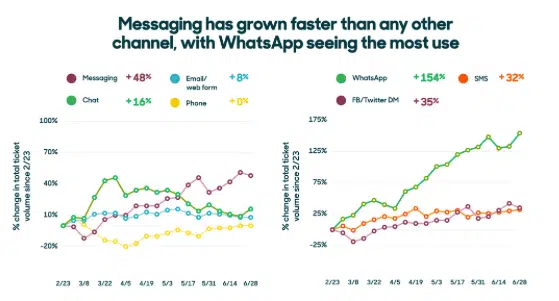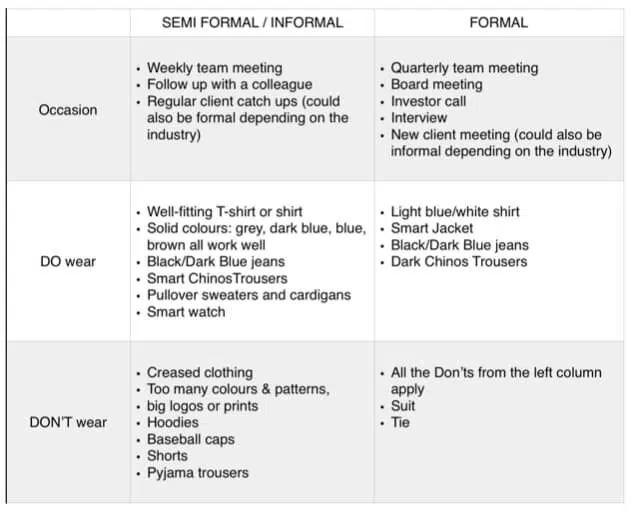Why seamless customer service must include messaging and social media
If your customer service and support isn’t omni-channel you are already behind the curve. Employing omnichannel customer service provides personalisation for a customer’s preferred platform, rapid response via messaging and social media, and an approach crafted to deal with the increasing adoption of mobile for customer service issues. Most importantly, omnichannel support maintains a customer service conversation without starting over with each new interaction.
Prefer to listen?
0 1
Multichannel versus Omnichannel
One of the biggest customer service trends over the past few years is the increased migration to digital platforms. Customers are looking for support throughout their journey and whether they find it in FAQs, online videos, or AI chatbots they want it where they want it and when they want it.
Availability is critical to the customer service experience. Your customer service goal is to keep the conversation moving with clear visibility into a customer’s history of interaction with your customer service group across all channels.
Multichannel customer service has been around for years, giving customers a choice of platform for receiving support. This includes everything from phone calls to Twitter. Multi channel support provides ease of use and a level of bespoke service depending on how the customer chooses to engage. However, multichannel customer support and omnichannel support are not the same thing.
Omnichannel customer support means there is no break in the conversation if a customer moves from Instagram to your website chat support. The conversation remains consistent and helps prevent feelings of frustration at having to repeatedly explain the same issue each time the conversation moves to a different platform.
A customer’s interaction history must be available on every channel and tied to their customer profile. This allows your agents to be more responsive and personalise the experience for the customer. An agent can review the notes from previous interactions and speak specifically to the customer’s needs.
What’s the best way to work with customer service requests on Twitter?
According to Sprout Social, you need to make sure you’ve thought through how you will employ Twitter when responding to customer concerns and what your social media knowledge base can adequately address.
- Think through your Twitter customer service strategy – This is your logistical step and there are questions you should address before moving forward.
- Who will oversee your customer support strategy?
- How do you craft your social media presence to align with your brand?
- Most importantly, which issues can you handle online and which should be referred to other channels? You should include links to your website for additional resources and more complex questions.
- Respond quickly – Feel the need for speed. 40% of customers want a response within the first hour of reaching out on social media. 79% of consumers expect to get a response within the first 24 hours. Be prompt even if you’re telling a customer you will have to get back to them.
- Know when to move conversations off-platform – Not every issue can be addressed on Twitter. Understand when things need to escalate or change platforms. Complex, time-consuming, or private issues need to be addressed with discretion.
- Pay attention to feedback – When someone tweets something negative or positive about your brand you should engage with a personalised response. Demonstrate your appreciation for the feedback and look for ways to resolve the issue or thank them for the positive feedback.
- Showcase your brand’s personality – Social media is a great platform for putting your brand voice front and center. It’s a more casual environment and allows you the opportunity to be more engaging and even demonstrate a sense of humor, when appropriate.
- Monitor brand mentions – Set up a social listening dashboard and look for all the places your brand pops up. Engage when you can and become part of the conversation.
- Be Human – Your customers should know there are people and not bots behind your Twitter responses. Use pronouns such as ‘we’ and feel free to include initials or names in the tweets to better humanize your brand response.
U.S. companies are losing $75 billion a year due to poor customer experiences, a $13 billion increase from 2016. Business Wire
0 2
Messaging Is Your Not-So Secret Weapon
2020 impacted the way we do business in many ways but one of the most eye-catching statistics for any CEO or business leader should be the shift to business messaging for addressing customer service issues. WhatsApp, text, and Twitter DM’s became the go-to means for support as more people began to send and receive messages with help agents. Recent surveys show that in the past year almost 1/3 of customers messaged a company for the first time and 3/4 of them indicated they will continue to do so moving forward.
Compare the rise in messaging numbers to those of traditional means such as phone support:
- WhatsApp tickets went up 219%
- SMS and Text Message up 30%
- Live Chat up 27%
- Social Media tickets jumped 26%
- Email and Webform up 16%
- Phone up 8%
Messaging isn’t only good for customers, agents also prefer it. Messages allow agents to work multiple tickets at a time and the customer conversations they are having don’t disappear when switching platforms or closing windows. Agents have better context to address customer issues while reviewing the history and taking in simultaneous chat streams. They have more control and with conversational views can improve their productivity by up to 30%.
For companies looking to be cost-effective, Forrester reports they can decrease costs up to 80% by relegating tickets to less expensive messaging channels and offering chatbots for self-service.
Messaging should be at the core of any omnichannel approach.

What’s the best way to measure success with online customer support?
According to the customer service company Acquire, here are the best metrics for determining how much customer communication is taking place on your online channels and how effective it is:
- First response time. How long are customers waiting for agents?
- Average response time per online channel?
- The number of engagements and inquiries across each channel.
- How often are customer enquiries positive and/or negative?
- CSAT (Customer Satisfaction) or NPS (Net Promoter Score) scores after the conversation.
- Topic clusters that identify trends such as defective products.
- Deflection rate — How often are customers pushed to other channels?
Companies that excel in engaging customers across channels can retain nearly 3x as much business as those without an omnichannel strategy. Aberdeen Group
Always have one eye on the goal
0 3
Social Media Customer Service Celebrations
Even before 2020, customers began taking their customer service issues to social media platforms. Now, ⅔ of customers expect a company to offer social networks as a customer service channel. Furthermore, 59% of US social media users believe social media has made customer service more convenient.
The trend of people taking to social media to seek help will continue, which means the fate of your brand may dangle across the precarious worlds of Instagram, Facebook, and Twitter. Therefore, you must have a customer service social media strategy.
The first part of your strategy should be speed. According to the website Sprout Social, “40% of consumers expect brands to respond within the first hour of reaching out on social media, while 79% expect a response in the first 24 hours.”
Your social media response doesn’t have to be a solution. You can use it to let customers know you are looking into their concerns. With some customer service groups reporting a 10X increase in inbound tickets, you can have your agents let customers know in real-time that you’re experiencing a high volume of requests and will be getting back to them within a set number of hours.
You can also humanize the experience with your brand because social media often takes on a less formal, more conversational tone with customer service engagements. This allows you the opportunity to separate yourself from your competitors by injecting some personality into your service and providing a great story for both the company and the client. You can lighten the mood for a customer who had a bad experience. Your customer service can become your marketing as studies show such interactions can increase customer advocacy by 25%.
A prime example of this forward-thinking is the direct-to-consumer beauty company, Glossier. Glossier integrated its customer service group into its marketing group to advise on product development and help build customer loyalty. As the most customer-facing group, the customer service arm of Glossier gains valuable insight into consumer response and trends.
Instead of agents, Glossier has editors, each with their own voice for addressing customer concerns. The editors aren’t looking for mere customer interactions, but strive to strike up conversations in a casual manner. Everything is highly personalized and conducted as much as possible on a one-on-one basis. One of its customer service triumphs went viral back in 2019:
“For example, two years ago, a bride-to-be wrote into Glossier, panicked about the fact that its website was out of its Haloscope highlighter, which she was hoping to use on her wedding day. One of the gTeam editors messaged everyone in the office to find out if they might have an unopened Haloscope sitting in their own makeup bags for the brand to send. They tracked one down and sent it her way. The newlywed was so pleased, she sent some of the final wedding pictures back to her gTeam contact.”
This type of story turns a customer service request into instant PR and identifies Glossier as a fun company willing to do whatever it takes to make a customer happy.
Blast that publicity across millions of social media followers and you have a story that not only resonates but is easily shared into the feeds of other potential customers.
Customer service is about being available when your customers need you. As times change, so will the ways you have to service customer issues. By providing a seamless approach tying multiple channels together and unifying customer data and their interaction history, you can become one of the brands your customers brag about, and that’s the kind of brand advocacy you just can’t buy.
For more tips and best practices on engaging customers, check out our course on Customer Service and Support.
Common Questions
The customer isn’t always right, but often they are. You must decide how to prioritize your needs against those of your customers. However, never turn your bad day into a bad customer experience.
Every situation is different and will require different customer engagement strategies. Weigh the costs of making a customer happy against those of letting them go.
This is a tough conversation. Ensure you carefully note the customer journey and present it to your boss. Explain why you think it’s time to move on and how you can use the free time to better serve other customers.
People will be able to see you and are more likely to pay attention to how you appear on a video call. Make sure you have time to dress appropriately and make yourself presentable before joining a call.
According to Artefact London, here’s how you should dress depending on the call:

One of the biggest complaints from video call users is poor audio because so many people rely on their computer’s built-in microphone. If video calls are going to be part of your work routine, you should look into a microphone that can up your game for presentations, pitches, and interviews.
The website Virtuoso Central compiled a list of the best quality microphones on the market for video conferencing:
-
Anker PowerConf – Bluetooth Speakerphone with 6 Microphones
-
Samson Go Mic – USB Condenser Microphone
-
eMeet M2 Max – Professional Video Conference Mic and Speaker
-
Shure MV5 – Digital Condenser Microphone
-
Samson Satellite Microphone
-
Blue Snowball iCE USB Mic
-
Rode NT-USB Condenser Mic
-
Shure MV88+ Stereo Condenser Microphone
Unless you have a clean space or are in a professional environment such as a home office, you should consider blurring your background on calls. This limits distraction and tidies up your appearance. It also maintains some level of privacy if you don’t want your colleagues seeing your personal space.
Most apps now make it easy to do and there are many online guides for setting it up correctly.
This is one of our executive briefings taken from our series of professional online business short courses from ELL. We have over 150 courses online with over 1,000 hours of e-learning covering a wide range of topics across leadership, management and personal & professional development created by industry experts and learning professionals.
Customer Service and Support
Customer Support used to mean just face to face or phone conversations. With technology today, this has fundamentally changed and includes a host of online solutions from websites, FAQ’s, web chat, phone apps and even chatbots. The customer experience has shifted online and begun long before a purchase is made. Our Customer Support course looks at the new opportunities in customer support available online and how to take advantage of them.
By the end of this short business course on Customer Support and Service you will:
- Understand the differences between customer support and customer service
- The channels that you can communicate with customers
- The tone of voice and how to react to customers of all types
- Keeping critical documentation
- Keeping a feedback loop open
In each of our business courses, you get access to around six hours of e-learning that you can watch, listen and read. There are usually 100 questions and at the end of the course you will receive a certificate of completion that you can use against any personal or professional development requirements. As well as the course, you also receive a FREE e-book that you can read on your Kindle or other e-reader. You also get a FREE audiobook of the course so you can listen to the whole course uninterrupted on your device.














